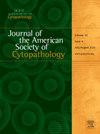人乳头瘤病毒基因型分布及其与上皮内瘤变、疫苗接种和种族的相关性
Q2 Medicine
Journal of the American Society of Cytopathology
Pub Date : 2025-04-07
DOI:10.1016/j.jasc.2025.03.006
引用次数: 0
摘要
宫颈癌主要归因于高危人乳头瘤病毒(HPV),特别是基因型16和18。引入人乳头瘤病毒疫苗的目的是减少子宫颈癌的发病率。材料和方法:本研究回顾了高级别鳞状上皮内病变(HSIL)和非典型鳞状细胞不能排除HSIL (ASC-H)的高危HPV和HPV基因分型数据阳性的病例。比较了不同种族和不同HPV疫苗接种状况的高级别上皮内瘤变(IN2+)患者中HPV基因型16/18和非16/18的患病率。结果:共274例(HSIL 94例,ASC-H 180例)被评估。非16/18型HPV在ASC-H中的患病率(68%)明显高于HSIL患者(50%);(p = 0.003)。非16/18型HPV在没有-IN2+的病例中更为常见(69%),但IN2+病例中非16/18型HPV基因型也呈阳性(56%);(p = 0.04)。总体而言,非16/18型HPV在所有种族中更为普遍。与白人和未接种疫苗的妇女相比,非白人和接种疫苗的妇女的患病率有更高的趋势,但差异不显著。结论:HPV非16/18基因型比HPV 16/18基因型更普遍,即使在高度病变的女性中,非白人和接种疫苗的女性也更倾向于非16/18基因型。该研究表明,需要扩大HPV基因分型和针对更广泛的HPV类型的疫苗,包括HPV非16/18,以改善预防,特别是在某些种族群体中。本文章由计算机程序翻译,如有差异,请以英文原文为准。
Human papillomavirus genotype distribution and its correlation with intraepithelial neoplasia, vaccination, and ethnicity
Introduction
Cervical cancer is primarily attributed to high-risk human papillomavirus (HPV), specifically genotypes 16 and 18. The introduction of HPV vaccines aimed to reduce the incidence of cervical cancer.
Materials and methods
This study reviewed cases of High-Grade Squamous Intraepithelial Lesion (HSIL) and Atypical Squamous Cells Cannot Exclude HSIL (ASC-H) with positive high-risk HPV and HPV genotyping data. The prevalence of HPV genotypes 16/18 and non-16/18 was compared in cases with high-grade intraepithelial neoplasia (IN2+), across different ethnicities and with HPV vaccination status.
Results
A total of 274 patients (94 HSIL and 180 ASC-H) were evaluated. HPV non-16/18 was significantly more prevalent in ASC-H (68%) than in HSIL patients (50%); (P = 0.003). HPV non-16/18 was more common in cases without -IN2+ (69%), but a significant proportion of IN2+ cases were also positive for non-16/18 HPV genotypes (56%); (P = 0.04). Overall, HPV non-16/18 was more prevalent in all ethnic groups. There was a trend to a higher prevalence in non-white and vaccinated compared with white and nonvaccinated women respectively, but the difference was not significant.
Conclusions
HPV non-16/18 genotypes are more prevalent than HPV 16/18, even in women with high-grade lesions with a greater shift towards non-16/18 genotypes in non-white and in vaccinated women. The study suggests the need for extended HPV genotyping and vaccines targeting a broader range of HPV types to include HPV non-16/18 to improve prevention, particularly in certain ethnic groups.
求助全文
通过发布文献求助,成功后即可免费获取论文全文。
去求助
来源期刊

Journal of the American Society of Cytopathology
Medicine-Pathology and Forensic Medicine
CiteScore
4.30
自引率
0.00%
发文量
226
审稿时长
40 days
 求助内容:
求助内容: 应助结果提醒方式:
应助结果提醒方式:


